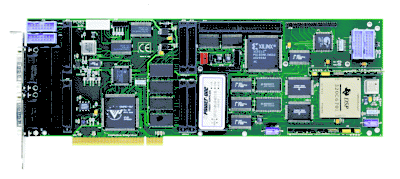M62/67 Flexible DSP/Data Acquisition Platform
- Overview
- Analog and Digital I/O Modules
- Specifications and Data Sheets
- Block Diagram
- Software Support
- About the Design and Manufacture of the M62/67
- Return to DSP Hardware Page
 Click on image to see full-size picture |
 Click on image to see full-size picture M67 board shown above with OMNIBUS module shown partially installed. Up to two (2) modules may be installed on the board |
Overview
The M62/67 board provides a flexible platform for a wide variety of DSP-based data acquisition applications. The M6x boards combine the power of the 32-bit fixed-point C6201 or 32-bit floating-point C6701 DSP devices with parallel DSP-accessible onboard SRAM and SDRAM memories, digital I/O, and analog I/O module options. Two (2) onboard OMNIBUS module sites provide a range of analog I/O options depending on which module (or modules) are installed, including: - sampling rates from dc to 20 MHz- multi-channel (2-32 simultaneous; up to 64 multiplexed)
- type of A/D and D/A conversion; e.g. SAR or sigma-delta
- range of bit resolution, from 12 to 24 Combinations of the above parameters are possible by mixing and matching the modules installed on the M6x board.
The C6201 is a 32-bit fixed-point device with 16x16 multiplies and 32-bit fixed-point results; the C6701 is a 32-bit floating-point device with 32x32 multiplies and 32-bit floating-point results.
The M62/67 baseboard is available in two (2) form factors:- full-size PCI (standard PC)
- 6U cPCI (Compact PCI)
M62/67 Analog and Digital I/O Modules
The M62/67 input/output philosophy is entirely modular, providing two (2) daughterboard sites for a wide array of "OMNIBUS" modules, including:- A4D4 4-channel 16-bit 200 kHz SAR analog I/O with 6-pole antialias filters and 2-pole reconstruction filters, and software programmable gain
- SD4 4-channel 24-bit 96 kHz sigma-delta analog I/O; 104 dB SNR typical
- SD16 16-channel 16-bit sigma-delta analog I/O, 82 dB SNR typical
- S16-HS High-Precision 16-channel 16-bit dc to 195 kHz sigma-delta input; high level of dc accuracy
- A16D16 16-channel 16-bit 100 kHz SAR analog I/O with 2-pole antialias filters and 1-pole reconstruction filters
- A16D2 16-channel 16-bit 2 MHz multiplexed input, 2-ch 16-bit simultaneous output.
- AIX 4-channel 16-bit 2.5 MHz SAR input, with anti-alias filters
- AIX20 4-channel 12-bit 20 MHz SAR input
- DAC40 4-ch 14-bit 40 MHz SAR output
- Analog I/O Breakout Panel




